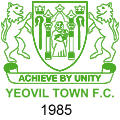Yeovil Town
In 1890 Yeovil FC organised games under both association and rugby codes. The modern club is, however, descended from Yeovil Casuals, formed in 1895, who wore green and white. In 1907 this club became known as Yeovil Town FC.
A second club, Petters United, was formed in 1908 and played in amber and black. After a few years as a junior club, Petters United entered senior competition and the rivalry between the two sides became intense. It became clear that the Somerset market town could not support two professional clubs and in early 1914 a merger was agreed. The new club, Yeovil & Petters United did not take the field until the end of the Great War when senior sides were entered in the Western League (Division Two) and the Dorset & Wiltshire League. The club moved into the Huish Ground, with its famous sloping pitch, in August 1920. After winning the Western League in 1922, the club joined the Southern League in 1923 and became a limited company.
In 1927, Yeovil made their first application to join the Football League but received only a single vote. In 1934-35, Yeovil achieved the first of their many FA Cup giant-killing acts by defeating Crystal Palace and neighbours Exeter City.
 When professional competition resumed after the Second World War the club adopted the name Yeovil Town and the unknown Alec Stock was appointed player-manager. In 1949 Yeovil created a national sensation when they beat Sunderland (then known as the "Bank of England" because of their dependability) in the fourth round of the FA Cup at Huish in extra time: for this game, Yeovil wore white sleeves with their usual green shirts, emblazoned with the town's coat of arms. These shirts (without the crest) then became their standard outfit for the rest of the decade.
When professional competition resumed after the Second World War the club adopted the name Yeovil Town and the unknown Alec Stock was appointed player-manager. In 1949 Yeovil created a national sensation when they beat Sunderland (then known as the "Bank of England" because of their dependability) in the fourth round of the FA Cup at Huish in extra time: for this game, Yeovil wore white sleeves with their usual green shirts, emblazoned with the town's coat of arms. These shirts (without the crest) then became their standard outfit for the rest of the decade.
Between 1955 and 1973, Yeovil won the Southern League three times and in 1979 they joined the Alliance  Premier league, forerunner of the Conference League. The club crest, loosely based on the Yeovil coat of arms, appeared in 1985.
Premier league, forerunner of the Conference League. The club crest, loosely based on the Yeovil coat of arms, appeared in 1985.
In 1989 work began on a new stadium to be called Huish Park: the last game played at the old Huish Ground was against Telford United on Saturday 5 May, 1990.
In 2003, Yeovil swept to the Conference championship by a record margin of 17 points to gain promotion to the Football League. After only two seasons, the Cider Men were champions of Coca Cola League Two (the old Fourth Division) in 2005.
